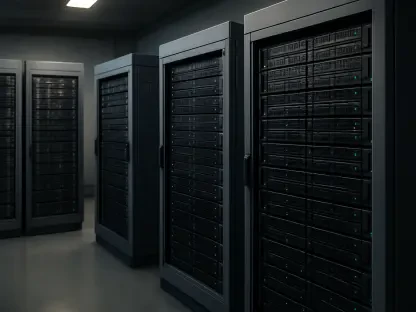In an era where cyber threats loom larger than ever, the cybersecurity industry stands as a critical shield for businesses worldwide, with data breaches costing companies billions annually. Varonis Systems, a key player in this high-stakes field, finds itself at a pivotal moment as it transitions from traditional on-premises software to cloud-based software-as-a-service (SaaS) models. This shift, while promising long-term stability, has brought immediate financial challenges, raising questions about the company’s ability to balance short-term losses with future growth. This report delves into Varonis’s journey, exploring the broader industry landscape, the company’s financial performance, and the strategic moves shaping its path forward.
Understanding the Cybersecurity and SaaS Landscape
The Current State of the Cybersecurity Industry
The cybersecurity sector remains indispensable as digital transformation accelerates across industries, exposing organizations to increasingly sophisticated threats. With ransomware attacks and data breaches becoming more frequent, businesses are investing heavily in solutions to safeguard sensitive information and infrastructure. Key areas such as data security, identity protection, and cloud-based defenses dominate the market, driven by the need to secure remote work environments and hybrid systems.
Major players, including Palo Alto Networks, CrowdStrike, and Varonis, compete to offer cutting-edge tools in a space projected to grow significantly over the coming years. This growth is fueled by a global reliance on technology, with cloud adoption and artificial intelligence reshaping how threats are detected and mitigated. As companies prioritize digital resilience, the demand for innovative cybersecurity solutions continues to surge, creating both opportunities and intense competition.
Significance of the Shift to SaaS Models
Across the tech industry, the move to SaaS has become a defining trend, offering scalability, flexibility, and cost efficiency to businesses seeking agile solutions. Unlike traditional software licenses, SaaS provides subscription-based access to tools hosted in the cloud, allowing companies to avoid hefty upfront costs and complex maintenance. This model has gained traction as organizations modernize their IT frameworks to support remote operations and real-time updates.
For cybersecurity firms like Varonis, the SaaS transition transforms revenue streams from one-time sales to recurring subscriptions, promising more predictable income over time. However, this shift often requires substantial investment in infrastructure and customer education, impacting short-term profitability. As SaaS adoption reshapes business models, it also redefines competitive dynamics, pushing companies to adapt swiftly to customer expectations for seamless, cloud-native experiences.
Varonis’s Financial Performance and SaaS Transition
Revenue Shortfalls and Widening Losses
Varonis reported third-quarter revenue of $161.57 million, falling short of market expectations by $4.5 million, a clear signal of the financial turbulence accompanying its strategic pivot. The shortfall stems largely from declining sales of term licenses and maintenance contracts, as customers increasingly migrate to the company’s SaaS offerings. This transition, while necessary, has strained traditional income sources, contributing to a net loss of $29.94 million for the quarter.
Operating losses also widened to nearly $36 million, reflecting the high costs of reorienting business operations toward cloud-based solutions. Despite these challenges, gross profits remained stable at $126.42 million, indicating that core margins have not yet eroded. The financial strain underscores the difficulty of navigating a rapidly changing market while maintaining operational stability.
Growth in SaaS and Future Projections
On a brighter note, SaaS now accounts for 76% of Varonis’s annual recurring revenue (ARR), marking a significant milestone in the company’s cloud journey. This shift highlights a successful pivot to subscription-based models, aligning with customer preferences for flexible, scalable solutions. The growing ARR from SaaS suggests a foundation for more consistent revenue streams in the long run.
Looking ahead, Varonis forecasts up to 8% year-over-year revenue growth for the fourth quarter, demonstrating cautious optimism about its trajectory. However, the company slightly lowered its full-year ARR guidance, reflecting uncertainties in the pace of customer adoption and legacy contract renewals. These projections indicate a path toward recovery, though the road remains bumpy as the transition unfolds.
Challenges in Transitioning to SaaS
Short-Term Financial Pressures
The move to SaaS has introduced immediate financial pressures for Varonis, primarily due to the decline in legacy on-premises software sales. As customers shift away from traditional licenses, revenue from these once-reliable sources has dwindled, creating gaps that new SaaS subscriptions have yet to fully bridge. This imbalance has directly impacted profitability, placing strain on the company’s balance sheet.
Additional challenges arise from reduced renewals, particularly among federal clients and long-standing customers accustomed to older systems. These segments, slower to adopt cloud solutions, represent a lingering drag on growth. Addressing these hurdles requires targeted strategies to accelerate customer migration while managing operational costs during the interim.
Balancing Short-Term Losses with Long-Term Gains
Navigating the trade-off between current financial difficulties and the promise of future stability remains a central challenge for Varonis. The SaaS model, while initially costly due to infrastructure investments and customer onboarding, offers the potential for steady, recurring income that could outweigh past volatility. This long-term vision drives the company’s persistence despite present setbacks.
This dynamic mirrors a broader industry trend where tech firms often endure temporary losses to achieve scalability and market relevance through cloud adoption. For Varonis, success hinges on maintaining customer trust during this transition while demonstrating the value of SaaS solutions. The ability to weather short-term pain for eventual gains will likely define its competitive standing in the years ahead.
Market Sentiment and Strategic Moves
Investor Confidence and Share Buyback
Despite financial headwinds, market sentiment toward Varonis remains largely positive, with analysts showing no sell ratings and setting a price target above current trading levels. This optimism reflects belief in the company’s strategic direction, particularly its focus on SaaS as a driver of future growth. Investors appear willing to overlook near-term losses in anticipation of stronger returns.
A $150 million share buyback program further signals confidence from the company’s board in its long-term value. This move, intended to bolster shareholder value, suggests internal faith in overcoming transitional challenges. Such actions reinforce the notion that Varonis is positioning itself for a robust recovery as the SaaS model matures.
Alignment with Digital Transformation Trends
Varonis’s pivot to SaaS aligns closely with the broader industry push toward cloud solutions and digital transformation. As businesses worldwide migrate to hybrid and remote environments, the demand for cloud-native cybersecurity tools has intensified, creating fertile ground for companies embracing this shift. Varonis’s strategy reflects an understanding of these evolving needs.
Investors increasingly favor firms that prioritize recurring revenue and margin expansion over one-off sales, viewing SaaS as a marker of sustainable growth. By focusing on cloud offerings, Varonis taps into this preference, potentially strengthening its market position. This alignment with transformative trends could serve as a competitive advantage if executed effectively.
The Future of Varonis and the SaaS Model in Cybersecurity
Emerging Opportunities in Cloud Security
As digital threats evolve, cloud security presents significant growth opportunities for Varonis, particularly in areas like data protection and threat detection across hybrid environments. The rise of remote work and cloud storage has heightened the need for robust, scalable solutions that can adapt to dynamic risks. Varonis stands to benefit by tailoring its SaaS offerings to address these emerging challenges.
Positioning itself as a leader in cloud-based cybersecurity could pave the way for sustained profitability and market dominance. By leveraging its expertise in data security, the company has a chance to capture a larger share of this expanding segment. Success will depend on continuous innovation and the ability to meet diverse customer demands in a crowded field.
Potential Disruptors and Economic Factors
Despite the promise of growth, Varonis faces potential disruptors, including fierce competition from established players and nimble startups in the cybersecurity space. Rapid technological advancements could also render current solutions obsolete if the company fails to keep pace. Staying ahead requires a commitment to research and development to maintain a cutting-edge portfolio.
Global economic conditions pose another layer of uncertainty, as budget constraints may slow customer adoption of SaaS models, especially among smaller enterprises. Fluctuations in IT spending could further complicate revenue forecasts. Adaptability and strategic foresight will be essential to navigate these external pressures and secure a lasting foothold in the market.
Conclusion: Weighing Challenges Against Potential
Summarizing Varonis’s SaaS Journey
Reflecting on Varonis’s path, the company has grappled with notable financial struggles, evidenced by revenue shortfalls and widened losses during its shift to SaaS. Despite these hurdles, the transition marks a strategic alignment with industry trends, as SaaS contributions grew to dominate annual recurring revenue. This balance of immediate pain against the backdrop of cloud adoption underscores a critical juncture for the firm.
Outlook and Recommendations
Looking back, the journey offers valuable lessons for navigating transformative shifts in technology. Moving forward, Varonis should prioritize enhancing its SaaS portfolio with user-friendly features and robust support to ease customer transitions from legacy systems. Additionally, targeted outreach to federal and traditional clients could help mitigate renewal declines, while strategic partnerships might accelerate market penetration. By focusing on these actionable steps, Varonis can build on investor optimism and position itself for enduring success in the evolving cybersecurity landscape.









